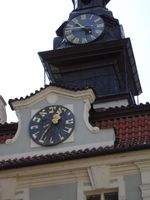 Just north of Old Town and the Charles Bridge, on the eastern banks of the Vltava River, is the Jewish Quarter that was once a confined ghetto from the Middle Ages where Prague's Jews were obliged to live. For centuries they suffered from oppressive laws, like having to wear a yellow circle as a mark of shame. As a pretext for a massacre, Christians often accused them of starting fires and poisoning wells.
Just north of Old Town and the Charles Bridge, on the eastern banks of the Vltava River, is the Jewish Quarter that was once a confined ghetto from the Middle Ages where Prague's Jews were obliged to live. For centuries they suffered from oppressive laws, like having to wear a yellow circle as a mark of shame. As a pretext for a massacre, Christians often accused them of starting fires and poisoning wells.In the 1890s the city authorities razed the ghetto because the area's complete lack of sanitation made it a health hazzard. What was saved was this Jewish Town Hall from 1570 (above), several synagogues, and the Old Jewish Cemetery.
 One of the synogogues, this Old-New Synagogue from 1270, is the oldest synagogue in Europe, surviving fires and massacres. Today it remains the religious center for Prague's Jews. A stone's throw from the synagogue is Europe's oldest surviving Jewish cemetery, barely the size of a football field, with its densely-packed gravestones. For 300 years, founded in 1478, this was the only burial ground permitted to Jews in Prague. People had to be buried on top of each other because of lack of space, up to 12 layers deep. Today over 12,000 gravestones represent an estimated 100,000 people thought to have been buried here, the last one being Moses Beck in 1787. The two most famous "residents" are kabala master and golem maker Rabbi Löew (died 1609), and financier Markus Mordechai Maisel (died 1601), who was banker to Emperor Rudolf II and was once one of the richest men in Europe.
One of the synogogues, this Old-New Synagogue from 1270, is the oldest synagogue in Europe, surviving fires and massacres. Today it remains the religious center for Prague's Jews. A stone's throw from the synagogue is Europe's oldest surviving Jewish cemetery, barely the size of a football field, with its densely-packed gravestones. For 300 years, founded in 1478, this was the only burial ground permitted to Jews in Prague. People had to be buried on top of each other because of lack of space, up to 12 layers deep. Today over 12,000 gravestones represent an estimated 100,000 people thought to have been buried here, the last one being Moses Beck in 1787. The two most famous "residents" are kabala master and golem maker Rabbi Löew (died 1609), and financier Markus Mordechai Maisel (died 1601), who was banker to Emperor Rudolf II and was once one of the richest men in Europe.I had originally assumed this cemetery was about the Holocaust and WWII. But no, sad to say, the prejudice goes back a lot farther than that! The Holocaust has been for ever!
You know by now how much I love cemeteries. So peaceful and calming to my frenzied spirit. This one, however, fits into a category all by itself. Though strangely "photogenic," (it was as though every stone beckoned me to take a "this do in remembrance of me" photo), it elicited a great blanket of sadness over me. Donica perceptively commented that the disarray and upheaval of the markers symbolically represent Jewish history throughout the ages. And as I reached out to touch a gravestone, my body wanted to heave in sobs.
Years ago as a teenager, I heard Dr. Bob Pierce from World Vision Int'l say, "Let my heart be broken by the things that break the heart of God."
Let's just say this cemetery broke my heart and left it in upheaval and disarray, just as I'm sure it did Yahweh's years ago, and most assuredly still does today.



I see what you meant, Boots. How incredible. It does make you wonder the "why" of it all.
ReplyDeleteRuth